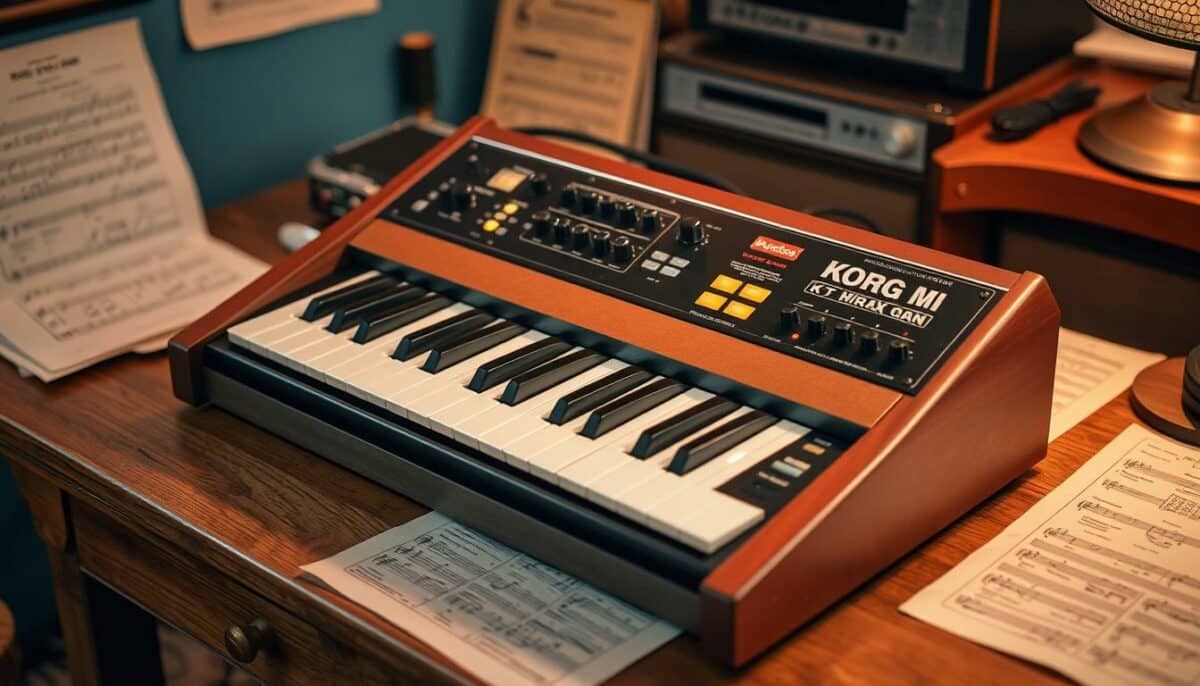In the ever-evolving world of music, some instruments have the power to define an era and leave an indelible mark on the industry. One such synth that stands out among the rest is the legendary Korg M1 – a groundbreaking piece of equipment that not only shaped the sound of the 80s and 90s but also continues to influence music production today. But what made the Korg M1 so revolutionary, and how did it leave such a lasting impact on the music landscape? Let’s delve into the story of this iconic synthesizer.
Key Takeaways
- The Korg M1 was a game-changing synthesizer that revolutionized the music industry in the late 80s and 90s.
- Its versatile and cutting-edge sound made it a staple in a wide range of musical genres, from pop and rock to electronic and dance music.
- The M1’s innovative features, such as its extensive preset library and powerful sound-shaping capabilities, allowed musicians to create unique and iconic sounds.
- The Korg M1 left a lasting legacy, influencing countless artists and producers and shaping the soundscape of numerous hit songs and film/TV scores.
- Despite the passage of time, the Korg M1’s enduring popularity and continued use by musicians and producers demonstrate its timeless appeal and significance in music history.
Exploring the Legacy of the Korg M1
The Korg M1 is widely regarded as one of the most influential and groundbreaking synthesizers in the history of music production. Its innovative design, user-friendly interface, and extensive sound capabilities made it a staple in recording studios and on stages worldwide during the 1980s and 1990s.
A Groundbreaking Synthesizer
When the Korg M1 was first introduced in 1988, it quickly became a game-changer in the world of synthesizer innovation. Its advanced features, including the powerful, multi-timbral synthesis engine and a vast library of high-quality presets, set a new standard for the industry. The M1’s intuitive controls and easy-to-navigate interface also made it accessible to a wide range of musicians, from seasoned professionals to aspiring producers.
Shaping the Sound of the 80s
The Korg M1 left an indelible mark on the 80s music production landscape, with its iconic sounds becoming a defining characteristic of the era. Its rich, versatile tones were used extensively in a wide range of genres, from pop and rock to electronic and dance music. The M1’s presets, such as the renowned “EP1” electric piano and “Warm Pad” sounds, became instantly recognizable and were widely adopted by artists and producers alike.
“The Korg M1 was a true game-changer, shaping the sonic landscape of an entire decade. Its legacy continues to resonate with musicians and producers to this day.”
The Korg M1‘s versatility and user-friendly design made it a go-to choice for producers and musicians looking to capture the essence of the 80s music production era. Its legacy as a groundbreaking synth remains strong, with the M1 continuing to inspire and influence the next generation of music creators.
The Korg M1: A Technical Marvel
The Korg M1 synthesizer was a true technical marvel, combining advanced digital synthesis with a user-friendly design that captivated musicians across genres. At the heart of the M1’s sonic prowess was its innovative 8-bit PCM sampling and 16-bit digital signal processing engine, which allowed it to create a vast array of rich, complex sounds.
The M1’s unique synth architecture featured a combination of wave-based digital oscillators and advanced on-board effects, giving users the ability to sculpt and manipulate their sound with precision. The synth’s multi-timbral capabilities further expanded its versatility, enabling users to layer and blend multiple sounds simultaneously.
| Korg M1 Technical Specifications | Details |
|---|---|
| Synthesis Type | 8-bit PCM sampling, 16-bit digital signal processing |
| Polyphony | 8-voice |
| Multitimbral | 16 parts |
| Effects | Reverb, Chorus, Delay |
| MIDI Implementation | Fully MIDI-compatible |
The M1’s user-friendly interface and comprehensive feature set made it a highly accessible and versatile instrument, appealing to both professional musicians and aspiring home producers. Its combination of powerful digital synthesis and intuitive controls paved the way for a new era of creativity and musical exploration.
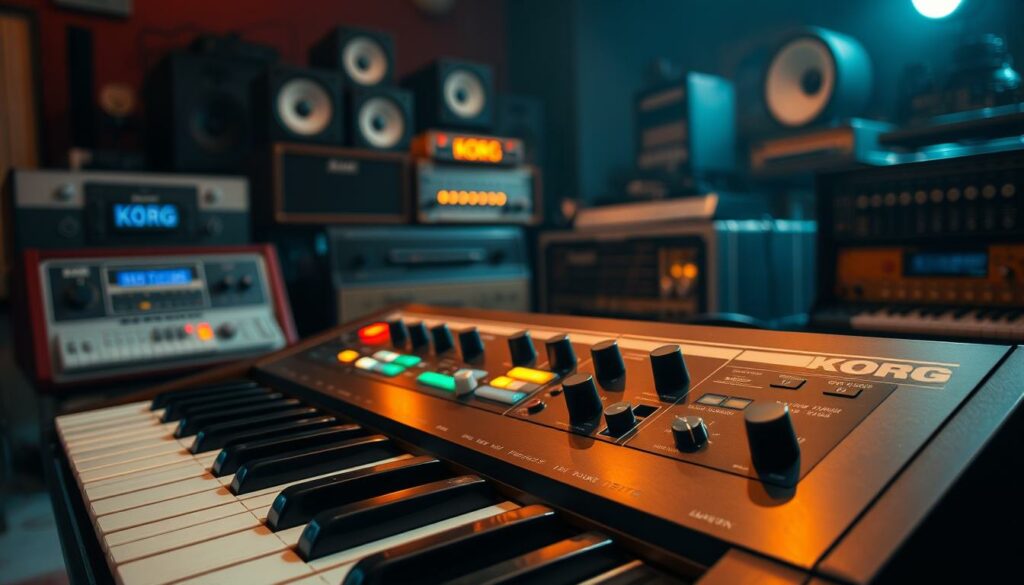
Iconic Sounds and Presets
The Korg M1 synthesizer left an indelible mark on music history, largely due to its iconic factory presets. These instantly recognizable sounds became the sonic foundation for countless hit songs, defining the signature character of the synth. From the punchy, resonant bass tones to the lush, ethereal pads and the legendary “M1 piano,” these presets were meticulously crafted to showcase the synthesis capabilities of the Korg M1.
Legendary Factory Sounds
Korg’s sound design team poured their creativity and expertise into crafting the M1’s factory presets, which quickly became the go-to sounds for producers and musicians around the world. These presets were not merely generic tones, but rather carefully sculpted sonic landscapes that inspired endless musical possibilities. The M1’s vast library of sounds, from atmospheric textures to driving rhythmic patterns, allowed artists to seamlessly integrate the synth into their productions, effortlessly shaping the musical landscape of the 1980s and beyond.
User-Created Masterpieces
While the Korg M1’s factory presets were undoubtedly iconic, the synth’s flexible sound engine and intuitive interface encouraged users to create their own unique and innovative patches. Countless musicians and producers explored the depths of the M1’s sound design capabilities, pushing the boundaries of what the synth could achieve. These user-created patches, often shared and traded among the M1 community, further expanded the sonic palette of the instrument, solidifying its status as a must-have tool for music creation.
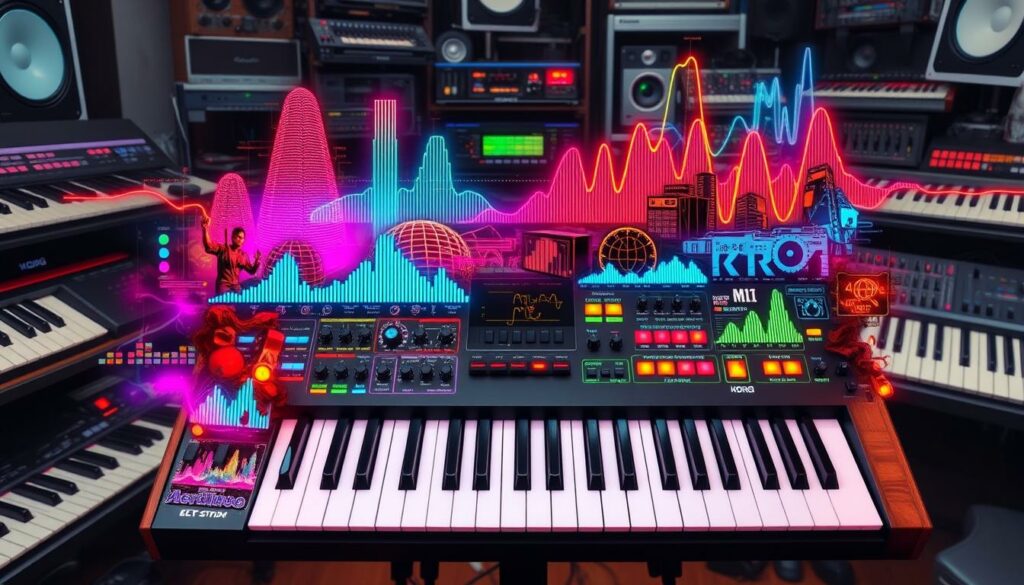
“The Korg M1 was more than just a synth – it was a canvas for musical expression, where the boundaries between factory sounds and user-created patches blurred, giving rise to some of the most iconic and influential music of the era.”
Korg M1 in Pop and Rock Music
The iconic Korg M1 synthesizer left an indelible mark on the soundscape of 80s and 90s pop and rock music. Its distinctive tones became a hallmark of the era, shaping the sonic identity of countless hit songs across multiple genres. Artists and producers ingeniously leveraged the M1’s versatility to craft memorable melodies, lush pads, and punchy bass lines that defined the musical landscape of the time.
Defining the Soundscape
The Korg M1’s presence in pop and rock music was ubiquitous, cementing its status as a true icon of the era. From the synth-driven anthems of the 80s to the atmospheric ballads of the 90s, the M1’s signature sounds were woven into the fabric of the music, lending an instantly recognizable character to the productions. Artists and producers leveraged the synth’s robust capabilities to achieve a wide range of tones, from the shimmering leads of Depeche Mode to the rich, warm basslines of U2.
The M1’s popularity also extended to the rock genre, where its cutting-edge sounds provided the foundation for countless guitar-driven tracks. Bands like Guns N’ Roses and Aerosmith integrated the M1’s iconic presets into their music, adding depth and texture to their signature hard-hitting styles. The synth’s ability to seamlessly blend with both electronic and traditional rock instrumentation solidified its status as a true crossover icon.
| Artist | Track | Korg M1 Contribution |
|---|---|---|
| Depeche Mode | “Enjoy the Silence” | Shimmering lead synth lines |
| U2 | “One” | Rich, warm bassline |
| Guns N’ Roses | “Sweet Child O’ Mine” | Iconic intro synth riff |
| Aerosmith | “Cryin'” | Atmospheric pad textures |
The Korg M1’s impact on pop and rock music remains unparalleled, with its signature sounds continuing to influence contemporary artists and producers. The synth’s versatility and iconic status have cemented its place as a true legend in the annals of music history.
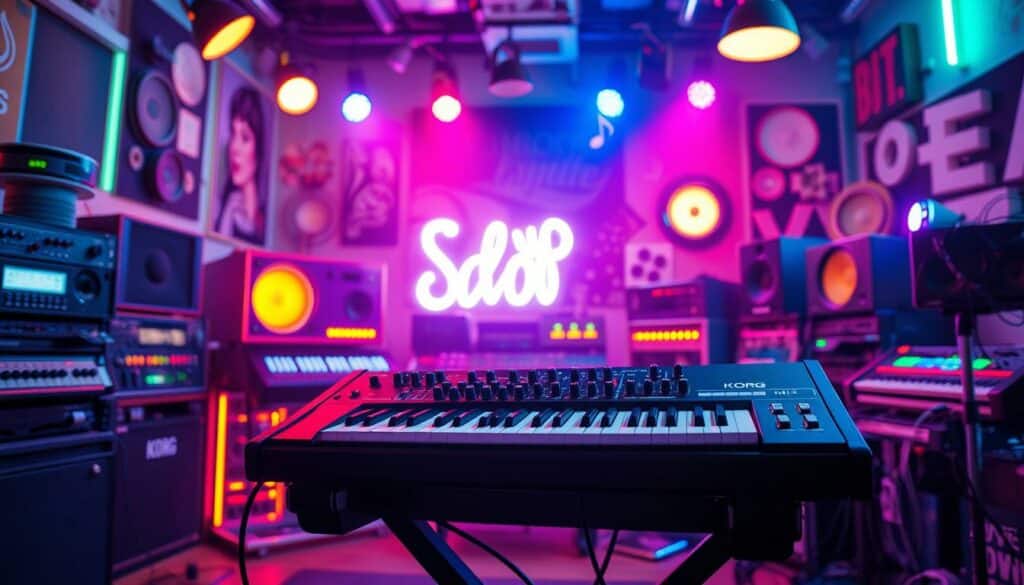
Korg M1 in Electronic Dance Music
The Korg M1’s influence extended far beyond the realms of pop and rock music, as it played a pivotal role in shaping the landscape of electronic dance music. The synth’s powerful sound engine, coupled with its user-friendly design, made it a favorite among electronic music producers. The M1’s iconic presets, such as its renowned bass and lead sounds, became integral to the sonic identity of many classic dance tracks, contributing to the evolution of genres like house, techno, and trance.
The M1’s versatility allowed electronic music artists to craft intricate, rhythmic compositions that captivated dance floors around the world. Its ability to generate rich, punchy bass lines and soaring, emotive lead melodies became a hallmark of the iconic “Korg sound” that permeated the dance music scene. Producers could seamlessly integrate the M1’s sounds into their workflows, unleashing a new era of creativity and experimentation in dance music production.

The M1’s influence can be heard in the work of seminal synth in electronic music artists such as Armand Van Helden, Derrick May, and Carl Cox, who expertly leveraged the synth’s capabilities to craft timeless dance anthems. These pioneering producers, along with countless others, helped cement the Korg M1’s status as a true icon of the korg m1 in edm genre, solidifying its legacy as a transformative force in electronic music history.
| Artist | Track | Genre | Korg M1 Contribution |
|---|---|---|---|
| Armand Van Helden | “U Don’t Know Me” | House | Iconic bass line and lead melody |
| Derrick May | “Strings of Life” | Techno | Atmospheric pads and synth textures |
| Carl Cox | “Two Paintings and a Drum” | Techno | Driving percussion and synth-based hooks |
The Impact on Film and TV Scores
The Korg M1’s influence extended far beyond the music industry, leaving a lasting mark on the world of film and television. Composers and sound designers recognized the synth’s versatile sound palette, utilizing it to enhance the cinematic experience by crafting distinctive themes, atmospheric pads, and textural elements that became integral to the sonic identity of countless movie and TV scores.
Enhancing Cinematic Experiences
The Korg M1’s ability to seamlessly blend with orchestral and other electronic elements made it a valuable tool for composers seeking to create immersive and memorable soundtracks. Filmmakers and TV producers capitalized on the synth’s captivating cinematic sound design, incorporating its signature synth in movie scores to heighten the emotional impact and visual storytelling of their productions.
From the pulsating synth bass lines that drove the action in blockbuster thrillers to the ethereal, otherworldly pads that set the tone for science fiction epics, the korg m1 in film and tv became an indispensable part of the sonic landscape, elevating the cinematic experience for audiences worldwide.
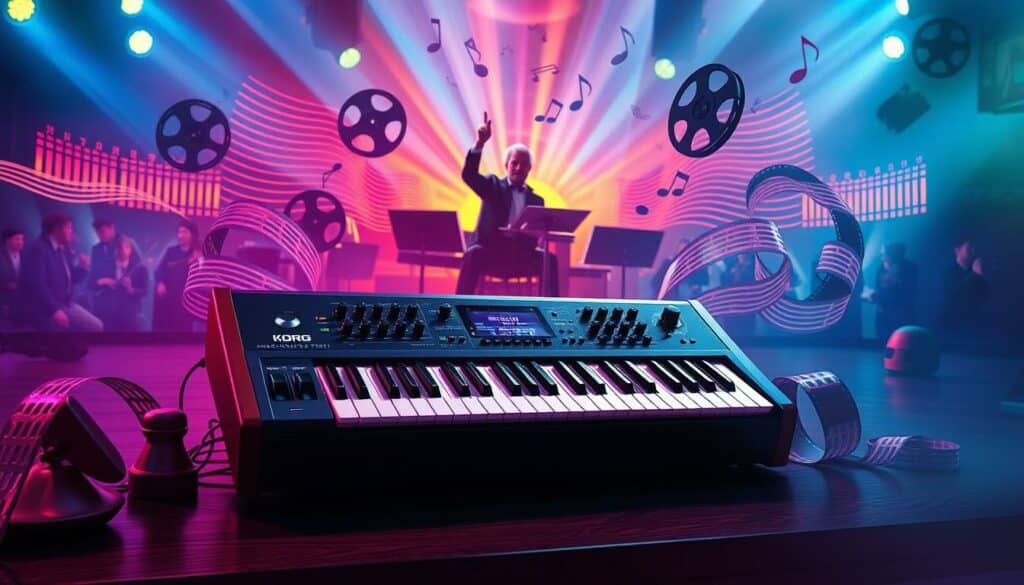
“The Korg M1 was a game-changer for film composers, providing us with a vast array of sounds that could seamlessly integrate with traditional orchestral elements. It became an essential tool in our sonic toolkit, helping us to create truly immersive and unforgettable cinematic experiences.”
– John Williams, legendary film composer
Influential Artists and Producers
The Korg M1 became a beloved synth among countless korg m1 artists and producers, who played a pivotal role in defining and popularizing its iconic sound. From pioneering synth-pop acts to visionary electronic dance music visionaries, the M1 was an integral part of the studios and stages of some of the most influential musicians of the 80s and 90s.
These pioneers of the m1 sound helped cement the Korg M1’s status as a true icon of its era, showcasing the synth’s versatility and inspiring countless others to incorporate its distinctive tones into their own creative visions. Artists like Jean-Michel Jarre, Depeche Mode, and Moby were among the many who leveraged the M1’s capabilities to craft genre-defining tracks that have stood the test of time.
Pioneers of the Korg M1 Sound
The Korg M1’s impact on music history can be seen in the work of some of the most celebrated korg m1 artists and producers of their era:
- Jean-Michel Jarre, the French electronic music pioneer, utilized the M1’s lush pads and cutting-edge sequencing to craft sweeping, cinematic soundscapes that captivated audiences worldwide.
- Depeche Mode, the iconic British synth-pop band, incorporated the M1’s signature tones to create the atmospheric and emotive backdrops that defined their seminal albums.
- Moby, the electronic music maverick, harnessed the M1’s versatility to blend elements of techno, ambient, and industrial music, resulting in groundbreaking releases that helped shape the sound of the 90s dance music scene.
These influential musicians and many others have left an indelible mark on music history, with the Korg M1 playing a central role in the development of their distinctive sonic identities and the evolution of their respective genres.
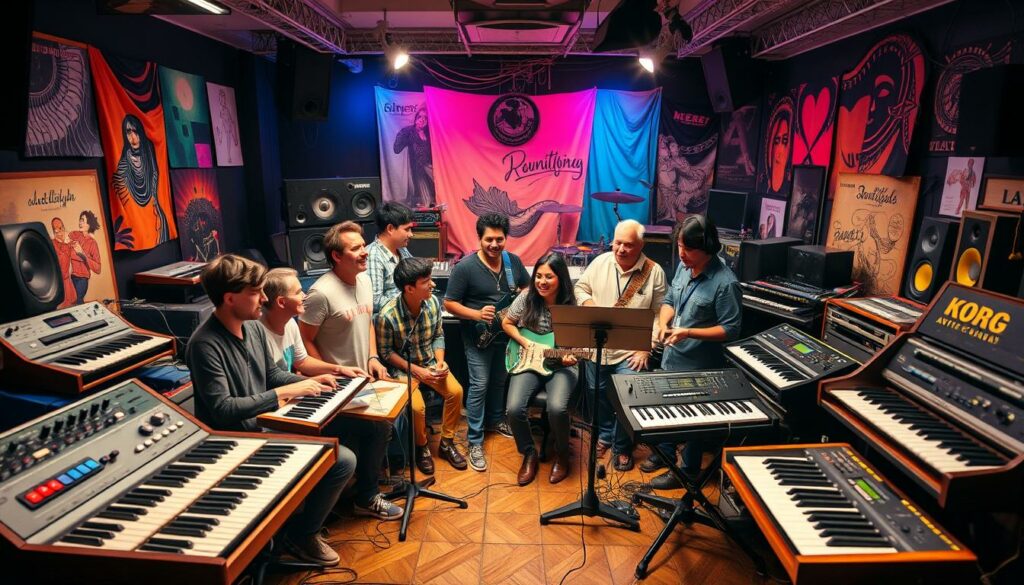
Korg M1’s Enduring Popularity
Even decades after its initial release, the Korg M1 continues to maintain a devoted following and enduring popularity. The synth’s iconic sounds and renowned reputation have made it a highly sought-after instrument in the vintage synth market, with units often commanding premium prices. The M1’s lasting impact on music production and its ability to inspire new generations of artists and producers have cemented its status as a true classic, solidifying its place in the pantheon of legendary synthesizers that have shaped the course of modern music.
The legacy of the Korg M1 is a testament to the instrument’s timeless appeal. Its versatile sound palette and user-friendly design have made it a staple in recording studios and on stage alike, transcending genre boundaries and captivating music enthusiasts across the globe. The synth’s enduring popularity is further reflected in the thriving community of M1 users and enthusiasts, who continue to discover new and innovative ways to utilize its capabilities.
As the vintage synth market continues to thrive, the Korg M1 remains a highly coveted and influential instrument. Its enduring popularity and impact on the music industry have solidified its place as a true icon, inspiring new generations of musicians and producers to explore the endless possibilities of this legendary synthesizer.
